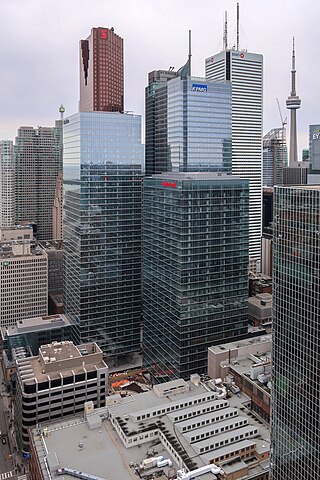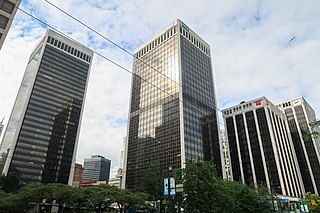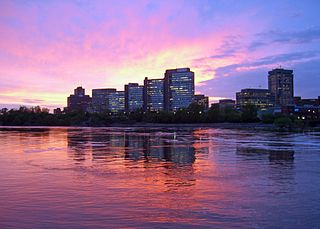Robert Joseph Antoine Campeau was a Canadian financier and real estate developer. Starting from a single house constructed in 1940 in the Alta Vista neighbourhood of Ottawa, Ontario, Campeau built a large land development corporation around the development of the suburb of Kanata. Expansion in the U.S. led Campeau to diversify into the ownership of retail department stores to anchor commercial development projects. The Campeau Corporation used leveraged buyouts to buy the department stores and went bankrupt when it could not maintain the debt payments, in the largest retailing bankruptcy at the time in U.S. history.

The Carlton Centre is a 50-storey skyscraper and shopping centre located on Commissioner Street in central Johannesburg, South Africa. At 223 metres (732 ft), it was the tallest building in Africa for 46 years from its completion in 1973 until 2019. It is today the continent's fifth tallest building after The Leonardo, the Mohammed VI Tower in Morocco, the Great Mosque of Algiers Tower in Algeria and the Iconic Tower in Egypt. The foundations of the two buildings in the complex are 5 m (16 ft) in diameter and extend 15 m (49 ft) down to the bedrock, 35 m (115 ft) below street level. The building houses both offices and shops, and has over 46 per cent of the floor area below ground level.

Place Ville Marie is a large office and shopping complex skyscraper in Downtown Montreal, Quebec, Canada, comprising four office buildings and an underground shopping plaza. The main building, 1 Place Ville Marie, was built in the International style in 1962 as the headquarters for the Royal Bank of Canada. While RBC's corporate headquarters and the majority of its management operations have been based in Toronto's Royal Bank Plaza since 1976, Place Ville Marie remains RBC's head office, a distinct title from its corporate headquarters. It is a 188 m (617 ft), 47-storey, cruciform office tower. The complex is a nexus for Montreal's Underground City, the world's busiest, with indoor access to over 1,600 businesses, numerous subway stations, a suburban transportation terminal, and tunnels extending throughout downtown. A counter-clockwise rotating beacon on the rooftop lights up at night, illuminating the surrounding sky with up to four white horizontal beams that can be seen as far as 50 kilometres (31 mi) away. This beacon is not considered as a NAVAID for aviation purposes.

The Sun Life Building is a historic 122-metre (400 ft), 24-storey office building at 1155 Metcalfe Street on Dorchester Square in the city's downtown core of Montreal, Quebec, Canada.

Downtown Ottawa is the central area of Ottawa, Ontario, Canada. It is sometimes referred to as the Central Business District and contains Ottawa's financial district. It is bordered by the Ottawa River to the north, the Rideau Canal to the east, Gloucester Street to the south and Bronson Avenue to the west. This area and the residential neighbourhood to the south are also known locally as 'Centretown'. The total population of the area is 5,501.

The Bay Adelaide Centre is an office complex in the Financial District of Toronto, Ontario, Canada. The first phase, a 51-storey skyscraper known as Bay Adelaide West, was completed in July 2009. The second phase, the 44-storey Bay Adelaide East, was completed in October 2016. A third tower, Scotiabank North Tower, opened in 2022 and serves the new global head office of Canadian bank Scotiabank.

The Suncor Energy Centre, formerly the Petro-Canada Centre, is a 181,000-square-metre (1,950,000 sq ft) project composed of two granite and reflective glass-clad office towers of 32 floors and 52 floors, in the office core of downtown Calgary, Alberta. The Council on Tall Buildings and Urban Habitat lists the west tower, as the 23rd tallest building in Canada and the 6th tallest skyscraper outside of Toronto, as of 2023. The west tower overtook the Calgary Tower as the tallest free-standing structure in Calgary from its completion in 1984, until being surpassed by the neighbouring Bow in 2010. The office towers encompass 158,000 m2 (1,700,000 sq ft) of rentable office space with the complex also containing 23,000 m2 (250,000 sq ft) of retail and underground parking area. A glass-enclosed walkway provides shelter and easy access to the surrounding buildings.

One Yonge Street is a 25-storey office building in Toronto, Ontario, Canada. The building served as the headquarters of Torstar and its flagship newspaper, the Toronto Star, from 1971 to 2022. It is 100 metres tall and built in the International style. It was built as a replacement to the Old Toronto Star Building, which was located at 80 King Street West. That building was torn down to make room for First Canadian Place.

The Bentall Centre is a 1.5 million square foot office complex and underground shopping mall, located in Downtown Vancouver's financial district. It is owned and managed by Hudson Pacific Properties. The shopping mall under the complex is known as "The Shops at Bentall Centre", and includes approximately 50 stores and a food court. The mall has a direct connection to Burrard Station of the SkyTrain network.

Campeau Corporation was a Canadian real estate development and investment company founded by entrepreneur Robert Campeau. It was infamous from its ultimately unsuccessful acquisitions of American department store holding companies Allied Stores in 1986 and Federated Department Stores in 1988. The whole organization soon was mired in bankruptcy and spurred the decline of the regional department store.

Place du Portage is a large office complex in the Hull sector of Gatineau, Quebec, Canada, situated along Boulevard Maisonneuve and facing the Ottawa River. It is owned and occupied by the Federal Government of Canada.

The Bow is a 158,000-square-metre (1,700,000 sq ft) skyscraper in downtown Calgary, Alberta, Canada. The 236 metre (774 ft) building was the tallest in Calgary between July 8, 2010, when it surpassed the Suncor Energy Centre, and May 11, 2016, when it was exceeded by Brookfield Place. The Bow is currently the second tallest office tower in Calgary and the third tallest in Canada outside Toronto. The Bow is also considered the start of redevelopment in Calgary's Downtown East Village. It was completed in 2012 and was ranked among the top 10 architectural projects in the world of that year according to Azure magazine. It was built for oil and gas company Encana, and was the headquarters of its successors Ovintiv and Cenovus.

Brickell City Centre is a large mixed-use complex consisting of two residential high-rise towers, two office buildings, a high-rise hotel, and an interconnected five-story shopping mall and lifestyle center covering 9 acres (36,000 m2) located in the Brickell district of Downtown Miami, Florida. Situated at the junction of Miami Avenue and Eighth Street, it spans up to five blocks to the west of Brickell Avenue and to the south of the Miami River. Contrary to the name, the development is not in the traditional downtown Miami city centre, but in the more recently redeveloped financial district of Brickell. The retail shopping and lifestyle center is operated by Simon Malls.

Brookfield Place is a skyscraper located in downtown Calgary, Alberta, Canada. The complex is home to Brookfield Place East, a 56-storey 247 m (810 ft) office tower, which, upon its completion in 2017, became the tallest building in Calgary, exceeding The Bow.

Ice District is a $2.5 billion mixed-use sports and entertainment district being developed on 10 hectares of land in Downtown Edmonton and a portion of the neighbourhood of Central McDougall. Its main attraction is Rogers Place, the home arena of the Edmonton Oilers professional ice hockey team. When completed the area will be Canada's largest mixed-use and entertainment district. The developers of the district are the Katz Group and the ONE Development Group. On July 13, 2015, it was announced that the area of the city surrounding the arena from 101 and 104 Street to 103 and 106 Avenue would be referred to as "Ice District" – a name created by Daryl Katz.

Stantec Tower is a 66-story building and 4 underground, 250.8 m (823 ft) mixed-use skyscraper in Ice District in the downtown core of Edmonton, Alberta, Canada. On May 23, 2018, it reached a construction height of 197 m (646.3 ft) and surpassed the JW Marriott Edmonton Ice District & Residences, becoming the tallest building in Edmonton and one of the largest mixed-use projects in Canada. The office area of the tower opened on September 26, 2018, and the residential portion opened in 2019.

Bellevue 600 is a future high-rise office building developed by Amazon in Bellevue, Washington, United States. It began construction in 2021 and is scheduled to be completed in 2024. The 43-story, 600-foot-tall (180 m) building would join 555 Tower as the tallest building in Bellevue. The project is located in Downtown Bellevue at the intersection of Northeast 6th Street and 110th Avenue Northeast, adjacent to the Bellevue Transit Center and a future Link light rail station. A second phase would construct a 27-story tower to the west, replacing an existing office building.

















